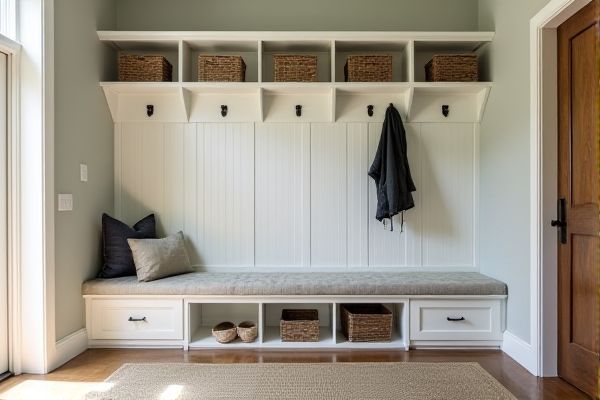
Vertical storage in a mudroom maximizes space by utilizing tall cabinets, hooks, and shelves that keep your items organized and easily accessible without taking up floor area. Horizontal storage, on the other hand, offers wide, lower compartments like benches with built-in bins, providing convenient seating while storing shoes and bags; discover which method best suits your mudroom's layout and your storage needs by reading the rest of the article.
Table of Comparison
| Feature | Vertical Storage | Horizontal Storage |
|---|---|---|
| Space Efficiency | Maximizes vertical wall space, ideal for small mudrooms | Utilizes floor area, suitable for wider spaces |
| Accessibility | Easier access to frequently used items at eye level | Good for bulky items, but may require bending or kneeling |
| Storage Capacity | Offers multiple shelves/hooks for organized storage | Provides large surface area, often with drawers or cubbies |
| Installation | Requires sturdy wall mounting and clearance height | Usually freestanding or built-in, may need floor reinforcement |
| Design Aesthetic | Modern, sleek look emphasizing vertical lines | Traditional, sturdy appearance focusing on horizontal layout |
| Ideal Usage | Small mudrooms, limited floor space, quick grab items | Larger mudrooms, storage of boots, baskets, and seating |
Introduction to Mudroom Storage Solutions
Mudroom storage solutions maximize space efficiency by utilizing vertical storage options such as wall-mounted hooks, shelves, and cubbies, which keep items like coats, bags, and boots organized and easily accessible. Horizontal storage typically involves benches with built-in compartments or under-seat storage, providing a convenient spot for sitting and storing bulkier items. Combining vertical and horizontal storage in mudrooms enhances organization, optimizes limited space, and improves overall functionality.
Understanding Vertical Storage: Definition and Benefits
Vertical storage in mudrooms maximizes space by utilizing walls and vertical surfaces to store items such as coats, shoes, and accessories through hooks, shelves, and cubbies. This method enhances organization by keeping frequently used items easily accessible while freeing up floor space for a cleaner, more efficient environment. Benefits include improved room flow, increased storage capacity in small areas, and a visually appealing, clutter-free setting.
Exploring Horizontal Storage: Definition and Advantages
Horizontal storage in a mudroom involves shelving, cubbies, or benches arranged side by side, maximizing accessible surface area for shoes, bags, and outdoor gear. This layout facilitates quick sorting and retrieval by placing items within arm's reach, enhancing organization in compact spaces. Your mudroom benefits from increased visibility and ease of maintenance, making horizontal storage an ideal choice for everyday functionality.
Space Efficiency: Vertical vs Horizontal Storage
Vertical storage in mudrooms maximizes space efficiency by utilizing wall height for hooks, shelves, and cabinets, freeing up floor area for movement and larger items. Horizontal storage, while offering easy access and surface space for seating or benches, can occupy valuable floor space, limiting room for pathways and additional storage. Choosing vertical storage solutions enhances organization in small or narrow mudrooms by optimizing unused vertical space.
Accessibility and Organization in Mudroom Storage
Vertical storage in mudrooms maximizes space by utilizing wall height, offering easy access to items like coats, bags, and shoes through hooks and shelves arranged at eye level. Horizontal storage provides flat surfaces or cubbies ideal for organizing larger or bulky items, ensuring they remain visible and reachable without stacking. Your choice between vertical and horizontal storage directly affects how efficiently you can organize and access daily essentials in a mudroom, optimizing both clutter control and convenience.
Maximizing Small Mudrooms: Vertical or Horizontal?
Maximizing small mudrooms involves choosing between vertical and horizontal storage solutions based on space and functionality. Vertical storage, such as tall shelves and wall-mounted hooks, optimizes limited floor space by utilizing wall height to store shoes, coats, and accessories efficiently. Horizontal storage, including benches with built-in compartments or low cubbies, provides easy access and seating but requires more floor space, making vertical options ideal for cramped mudrooms seeking to maximize every inch.
Aesthetics: Visual Impact of Storage Orientations
Vertical storage in mudrooms creates a sleek, modern aesthetic by emphasizing height and drawing the eye upward, which can make the space appear larger and more organized. Horizontal storage offers a more traditional, grounded look, providing easy access and a balanced visual flow that complements wide walls or bench areas. Your choice between vertical and horizontal storage impacts the overall visual harmony and perceived spaciousness of the mudroom.
Safety and Usability Considerations
Vertical storage in mudrooms maximizes space efficiency by keeping items off the floor, reducing tripping hazards and improving safety. Horizontal storage offers easy access to frequently used items, enhancing usability but may lead to clutter if not well-organized. Your choice should balance safe, clear pathways with convenient reach to optimize both safety and functionality.
Customization Options for Vertical and Horizontal Storage
Vertical storage in mudrooms offers versatile customization options such as adjustable shelves, built-in hooks, and tall cabinets designed to maximize wall space efficiency. Horizontal storage, often featuring benches with cubbies or low-profile drawers, allows for personalized seating areas combined with accessible storage compartments tailored for shoes, bags, or sports gear. Both storage styles can be customized with materials, finishes, and modular components to optimize organization while complementing the mudroom's overall design aesthetic.
Which Storage Style Fits Your Mudroom Needs?
Vertical storage maximizes limited mudroom space by utilizing wall-mounted shelves, hooks, and cabinets to keep items like coats, bags, and shoes organized and easily accessible. Horizontal storage, such as benches with under-seat compartments or low shelving units, offers convenient seating combined with accessible storage, ideal for placing boots or baskets. Choosing between vertical and horizontal storage depends on your mudroom's size, daily usage, and the types of items you need to store efficiently.
 homyna.com
homyna.com